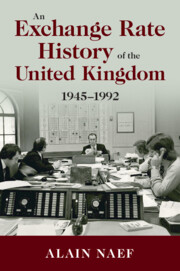Book contents
- An Exchange Rate History of the United Kingdom
- Studies in Macroeconomic History
- An Exchange Rate History of the United Kingdom, 1945–1992
- Copyright page
- Contents
- Figures
- Tables
- Acknowledgements
- Introduction
- 1 Sterling’s Post-War Role and Lessons from the 1947 Convertibility Crisis
- 2 The 1949 Devaluation
- 3 The Reopening of the London Foreign Exchange Market
- 4 The Bank on the Market
- 5 The Reopening of the London Gold Market in 1954
- 6 1958 Convertibility and Its Consequences
- 7 The Gold Pool
- 8 Cooperation and the Fed Swap Network
- 9 The 1964–1967 Currency Crisis
- 10 The 1967 Devaluation and the Fall of the Gold Pool
- 11 The Consequences of the Devaluation
- 12 Britain, Nixon and the End of Bretton Woods
- 13 The 1976 IMF Crisis
- 14 Britain’s Last Currency Crisis
- Conclusion
- Data Availability
- References
- Index
- References
References
Published online by Cambridge University Press: 23 September 2022
- An Exchange Rate History of the United Kingdom
- Studies in Macroeconomic History
- An Exchange Rate History of the United Kingdom, 1945–1992
- Copyright page
- Contents
- Figures
- Tables
- Acknowledgements
- Introduction
- 1 Sterling’s Post-War Role and Lessons from the 1947 Convertibility Crisis
- 2 The 1949 Devaluation
- 3 The Reopening of the London Foreign Exchange Market
- 4 The Bank on the Market
- 5 The Reopening of the London Gold Market in 1954
- 6 1958 Convertibility and Its Consequences
- 7 The Gold Pool
- 8 Cooperation and the Fed Swap Network
- 9 The 1964–1967 Currency Crisis
- 10 The 1967 Devaluation and the Fall of the Gold Pool
- 11 The Consequences of the Devaluation
- 12 Britain, Nixon and the End of Bretton Woods
- 13 The 1976 IMF Crisis
- 14 Britain’s Last Currency Crisis
- Conclusion
- Data Availability
- References
- Index
- References
Summary
- Type
- Chapter
- Information
- An Exchange Rate History of the United Kingdom1945–1992, pp. 229 - 238Publisher: Cambridge University PressPrint publication year: 2022
- Creative Commons
- This content is Open Access and distributed under the terms of the Creative Commons Attribution licence CC-BY-NC-ND 4.0 https://creativecommons.org/cclicenses/



